From February 2017 until the end of the year, I sent 157 items to my Sunday Recommendations list. For recurring supporters, I recommended 31 more. The items in this post are my own favorites. They include nine items that were originally shared only with recurring supporters. I limited myself to one favorite per genre of art, but sometimes couldn’t resist a couple runners-up, and ended up with two ties.
My comments are included below if they originally appeared in my Sunday emails. If the recommendation was in a blog post, I’ve linked to it. Recurring supporters have access to a compilation of all recommendations, updated monthly.
Literature
Fiction
Walton, Jo. The Small Change trilogy: Farthing, Ha’penny, Half a Crown. Set in an alternate-history Great Britain where the government made a pact with Hitler. The trilogy starts as a murder mystery and ends as a political thriller. Appealing characters, plausible motivations, and a satisfying outcome that I did not see coming.
Poetry
Hugo, Victor. “Be like the Bird …” (1836).
- Runners-up: Longfellow, “Day Is Done“; O’Shaugnessy, “Ode“; Smith, “Evolution“
Drama
OdysseusI know well, child, that by nature you aren’t madeTo speak or to do evil;But since it’s pleasant to be victorious,Have courage! And some other time, we’ll show ourselves just.Give yourself to me now, dear boy, for one short, shameless day,And then, for all the future, you can be calledThe most pious of mortals.NeoptolemusIt pains me to hear such things spoken of,Child of Laertes; and I hate doing such things, too.It’s not my nature to do evil –My father, they say, was just the same way.But I’m ready to bring Philoctetes by force,Instead of deception. The man has only one foot:He’ll never overcome all of us by force.Since I’ve been sent as a helper for you, I cringeFrom betraying you; but, my lord, I’d preferTo fail while acting rightly, rather than to win by doing evil.
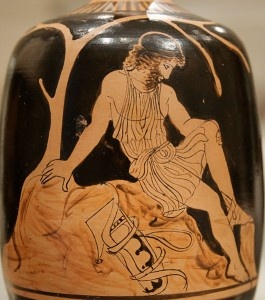
Short Story
Children’s Book
Visual Arts
Painting

Campin, Robert, a.k.a. the Master of Flemalle. Portrait of a Woman (ca. 1430). I wrote my way through an analysis of a remarkable portrait of an intriguing woman: Part 1 and Part 2. (Is she smiling or not?)
- Runners-up: Earl, Elijah Boardman (1789); Hals, Willem Coymans
Watercolors
Drawing
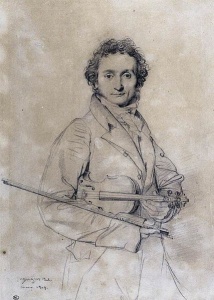
Sculpture
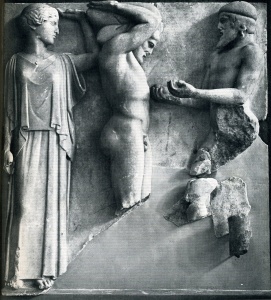
(Recommendation for supporters) [Greek sculpture]. Atlas, Herakles, and Athena metope. Of all the representations of Atlas that I’ve seen – and as a fan of Atlas Shrugged, I keep my eye out for them – this is my favorite. It was carved in the early 5th century B.C. for the Temple of Zeus at Olympia. I love its clean, simplified style. It’s also the only image I know in which Atlas is not bowed beneath the weight of a tremendous burden. Why not? As one of his 12 labors, Herakles was ordered to fetch the golden apples guarded by the Hesperides, daughters of Atlas. Only Atlas could persuade them to hand the apples over, but Atlas had been condemned by Zeus to hold the sky on his shoulders forever. (It was the sky rather than the earth, and the back story is worthy of Game of Thrones. Google “Titanomachy”.) Herakles agreed to assume the burden while Atlas collected the apples. In the usual version of the myth, when Atlas returned he refused to take the sky back, but Herakles tricked him – he asked Atlas to take the sky back for a moment so Herakles could put a cushion on his neck, and then Herakles ran off. Clearly that’s not what’s happening here. The pillow’s already in place, yet Atlas is reaching out his hands to take the burden back. I like to think that Herakles, being as yet only semi-divine (father Zeus, mother mortal) is shorter than the gods Athena or Atlas, so when he took the sky from Atlas, he needed a pillow on his neck to keep the sky at the right height. A drawing of all 12 of the Olympia metopes is here, about two-thirds of the way down. The Perseus site has the Herakles story illustrated with Greek vase paintings: great fun.
- 1st of 3 runners-up: Clodion, Model for the Balloon Monument.
- 2nd of 3 runners-up: Lysippus, Agias, at the Delphi Archeological Museum (4th c. BC). I entered college with a year of Latin, three years of French, and writing skills that earned me a National Council of Teachers of English scholarship. What to take instead of freshman English? Hmmm … Modern Greek. Exotic! A whole new alphabet! And, as the young and enthusiastic professor pointed out, if you study Classics, you can study Greek or Roman literature, language, history, archeology, art, science, philosophy … I had intended to major in psychology, but the Psych 101 professor was deeply committed to behavioral modification of rats. Modern psychology didn’t stand a chance against Aristotle, Aeschylus, Aristophanes, amphorae, and Athens, never mind the delights lurking in the rest of the Greek alphabet. Two years later, with courses in Ancient Greek Everything under my belt, I wrote an essay in Modern Greek that won me a six-week trip to Greece. I still remember forgetting to breathe when I first saw the Zeus of Artemisium (but he was famous) and the Charioteer of Delphi (but he was famous, too). Agias left me speechless because it’s an amazing work, competing with so many other amazing works that it didn’t make the cut for the art history books! How could I not want to spend more time with the Greeks? So I did: five years in grad school, and years of freelance study since. More pics of Agias here.
- 3rd of 3 runners-up (Recommendation for supporters): Saint Gaudens, Cornelius Vanderbilt, 1882. One of my heroes among artists created a portrait of one of my heroes among businessmen: how perfect is that? Saint Gaudens, who began his career carving cameos and was always remarkably good at low relief, sculpted this portrait for the lavish home of Cornelius Vanderbilt II on Fifth Avenue. The MMA’s site notes that the elder Cornelius is “posed in profile against a dense background of oak leaves and acorns. This motif, symbolizing strength and regeneration, was adapted from the family coat of arms, visible at the lower right.” If you don’t know anything about Cornelius except what the muckrackers said, I highly recommend T.J. Stiles, The First Tycoon. If you haven’t seen this work at the MMA yet, it’s because they didn’t acquire it until 2016. It hangs in the galleries near the Frank Lloyd Wright room.
Museums (Five Favorites series)
Brookgreen Gardens. I really do need to go back there.
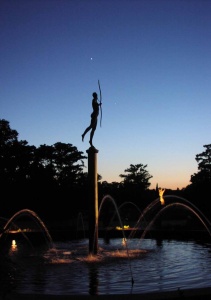
- Runners-up: The problem with this category is that I only chose museums whose works I liked, and within each museum, only works that I liked very much. So the runners-up are all the others in the Five Favorites series: Gemäldegalerie Alte Meister in Dresden (for Duke Henry and Vermeer), National Gallery in Athens (Zeus and Aristonautes), Borghese (Bernini), d’Orsay (The Dance), Gardner (Bunker), Walters (Marchese), Capodimonte (Boldini and Antea).
Music
Orchestral Music
Tchaikovsky. “Violin Concerto in D major, Op. 35” (1878). The piece performed at the end of The Concert. Watch Joshua Bell perform it with the Youth Orchestra of the USA led by Valery Gergiev, or see Itzhak Perlman and Eugene Ormandy with the Philadelphia Orchestra.
- Runner-up (Recommendation for supporters): Beethoven. The Creatures of Prometheus (1801). I had never heard this work before: it’s Beethoven’s only music for ballet, which was at the time a new genre. It’s seldom performed in its entirety because the choreography notes have been lost. According to the notes in the original program (quoted here), “The ballet presents two animated statues who, by the power of harmony, are made susceptible to all the passions of human existence. Prometheus takes them to Parnassus, to receive instruction from Apollo, god of the arts, who commands Amphion, Arion, and Orpheus to teach them music; Melpomene and Thalia, tragedy and comedy. Terpsichore aids Pan, who introduces them to the Pastoral Dance, which he has invented, and from Bacchus they learn his invention – the Heroic Dance.” The theme from the ballet’s finale reappears in 1804, with gusto, in Beethoven’s Symphony No. 3, which means the “Eroica” has ties to both Prometheus and Napoleon. If you can’t remember a theme unless you see it in print (yup, that’s me: a very visual type), here it is. And incidentally, I’d translate “Die Geschöpfe des Prometheus” as “The Creations of Prometheus” rather than “The Creatures of Prometheus”; but that won’t help you if you’re Googling the work. This rather gorgeous video from 2014 features the Orchestre de Chambre Pelléas conducted by Benjamin Levy, at the Concertgebouw in Amsterdam. Thanks for assistance on this one to my friend and colleague Sara E.
Broadway Musicals
Wilkinson, Colm. Stage Heroes. One of my favorite collections of Broadway songs. Wilkinson originated the role of Jean Valjean in Les Miserables (West End and Broadway); in the recent movie version he sang the Bishop of Digne.
Opera
Handel, G.F. “Tornami a vagheggiar,” from Alcina. More on Alcina here, here, and here.
- Runner-up (Recommendation for supporters): I first saw Alma Deutscher (b. 2005) on a 60 Minutes interview. An accomplished pianist and violinist, she has already composed a piano sonata, a concert for violin and orchestra, and a full-length opera, Cinderella, in which the Prince recognizes Cinderella not by her shoe but by the song she sings. From Wikipedia: “[Alma] explained [in February 2017] that some people have expressed to her the view that one should not compose beautiful melodies in the 21st century, but that music must reflect the complexity and ugliness of the modern world. ‘But I think that these people just got a little bit confused. If the world is so ugly, then what’s the point of making it even uglier with ugly music?'” NOTE: Alma’s Cinderella was performed in English by the San Jose Opera in December 2017; as of 1/5/2018, the full opera can be viewed on Medici.tv (sign up for a free account).
Movies and TV
Justified (6 seasons). From the Amazon blurb: “U.S. Marshal Raylan Givens (Timothy Olyphant) confronts murder, drugs, bank heists, mobsters, crime families, corrupt politicians and even his own tumultuous past – and never backs down.” Binge-worthy TV (although I still hate Elmore Leonard’s books).
- 1st runner-up: Beauty and the Beast (2017 movie). As the slightly peculiar, nose-in-a-book girl in my H.S. class, I’ve always sympathized with Belle’s search for someone who gets as excited as she does about what lies beyond her immediate circle. I loved seeing this story again, loved Emma Watson, loved hearing the Menken & Ashman score again (the 3 added songs aren’t as good, but not terrible), hated Gaston as always, and thought the 3D was quite good (usually not a big fan). — Incidentally, I always consult Metacritic for move reviews: they give separate ratings for critics and normal people, and the difference often helps me decide whether or not to see a movie.
- 2nd runner-up (Recommendation for supporters): Wonder Woman (2017 movie). This is like the early Marvel superhero movies, when there were so few characters that we had time to get acquainted with and invested in them. I thoroughly enjoyed seeing two charming people figuring out what was they thought was right (even though I didn’t agree with their particular values) and then doing it.
Architecture
The Chanin Building, an Art Deco marvel.
Decorative Arts
A tie: Wrought iron (a selection of some of my favorites from New York and nearby) and American silver (a selection of my favorite pieces from the Metropolitan Museum’s collection).
Nonfiction
Books
Another tie: Bellos, David. The Novel of the Century: The Extraordinary Adventures of Les Miserables (2017). This is exactly the sort of historical writing on literature that I love: it gives the context of Les Miserables and lets me see it in a new light. It’s wonderfully free of academic verbiage, although written by someone with a vast knowledge of 19th-c. France. Bellos discusses the structure of Les Miserables; details such as settings, colors, money, and argot; what those long “digressions” are for; Hugo’s views on politics and religion; why the book took so long to write; the publishing process ca. 1860; the choices of characters’ names; and much more. Bellos also discusses some of the adaptations to stage and screen, including one by Hugo’s son. Utterly fascinating. HT to Quent C. for the recommendation.
AND Rappleye, Charles. Robert Morris: Financier of the American Revolution. A fascinating angle on the American Revolution: how did we pay for it? This bio covers Morris’s career as a businessman and his efforts to arrange financial support for the Revolution.
- 1st Runner-up: Greenblatt, Stephen. Will in the World: How Shakespeare Became Shakespeare (2016). Full disclosure: ever since I had to slog through printed Shakespeare in twelfth-grade English, I’ve avoided reading his works. I’ve loved every play Shakespeare play that I’ve seen performed, but in reading him, it was difficult to get past some of the language (including most of the jokes) – plus, all his famous lines now sound like cliches and I know the endings to all his stories. Greenblatt’s book allowed me to dump some of that baggage, because it set Shakespeare’s writings in a new context: the historical situation and earlier dramatic versions of the same stories. Greenblatt also talks about the structure of the plays. The passage that persuaded me to buy the Kindle version (after listening to the Audible) was this:
The crucial breakthrough in Hamlet did not involve developing new themes or learning how to construct a shapelier, tighter plot; it had to do rather with an intense representation of inwardness called forth by a new technique of radical excision. He had rethought how to put a tragedy together – specifically, he had rethought the amount of causal explanation a tragic plot needed to function effectively and the amount of explicit psychological rationale a character needed to be compelling. Shakespeare found that he could immeasurably deepen the effect of his plays, that he could provoke in the audience and in himself a peculiarly passionate intensity of response, if he took out a key explanatory element, thereby occluding the rationale, motivation, or ethical principle that accounted for the action that was to unfold. The principle was not the making of a riddle to be solved, but the creation of strategic opacity.That helps me understand why I’m often bored when modern fiction writers spell out their characters’ motivations. I’m far more engaged when I have to work out why they’re behaving as they do. Immediately after I finished Greenblatt, I read and enjoyed (!!!) The Tempest and King Lear. However, I still miss many jokes of characters such as Lear’s Fool that I’d probably understand if a good actor performed the part on stage. So I’m not giving up videos and live performances!
Caveat: as a sometime biographer, the amount of sheer speculation that Greenblatt has to use to “fill in” details of Shakespeare’s life (especially his early life) makes me wince; but even if the speculation is wrong, Greenblatt does a great job of describing late 16th- and early 17th-century England. HT to Ann M. & Susan S. for recommending Greenblatt.
- 2nd Runner-up: Zinsser, William. “Two Men and a Portrait” (2007) A fascinating article by William Zinsser (author of the classic On Writing Well) about having Thomas S. Buechner paint his portrait. It helped me to understand the sort of choices portrait artists make. Buechner’s How I Paint: Secrets of a Sunday Painter includes more of his paintings and comments, including an image of an onion that looks more real than an onion (p. 50) and his explanation of the effect Leutze’s Washington Crossing the Delaware had on him. You should at very least click on the Amazon link to see the portrait on the cover.
Podcast
How I Built This. Half-hour interviews with men and women who have built very successful companies, from Spanx to Sam Adams to Zumba. Informative and uplifting, even when some of the explicit philosophy is wrong.
Food
(Recommendation for supporters) James Beard Foundation dinner (9/26/2017). Premise: since we depend on the evidence of our senses to know the world around us, we should train ourselves to pay attention to all of them. I was raised on a farm with meat-veggie-potatoes meals, where the beef was always well done (because we knew that cow) and the only condiment on the table was salt. My first tasting menu at a top NYC restaurant was a revelation: I never knew that food could be prepared so carefully, presented so elegantly, and have such amazing flavors and textures. In September, for my husband’s birthday, we had a meal at the James Beard Foundation, which offers the equivalent of Oscars to chefs. The Beard is one of the best fine-dining deals in NYC: we had 3 appetizers while enjoying the Beard’s garden, then a 6-course meal that included thin slices of foie gras terrine, ravioli stuffed with baby artichokes in a delicious sauce, risotto with lobster, duck, and a donut-like pastry with pistachio filling and concord grape sherbet on top.
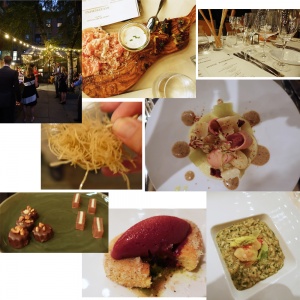
More
- Want wonderful art delivered weekly to your inbox? Check out my free Sunday Recommendations list and rewards for recurring support: details here.
